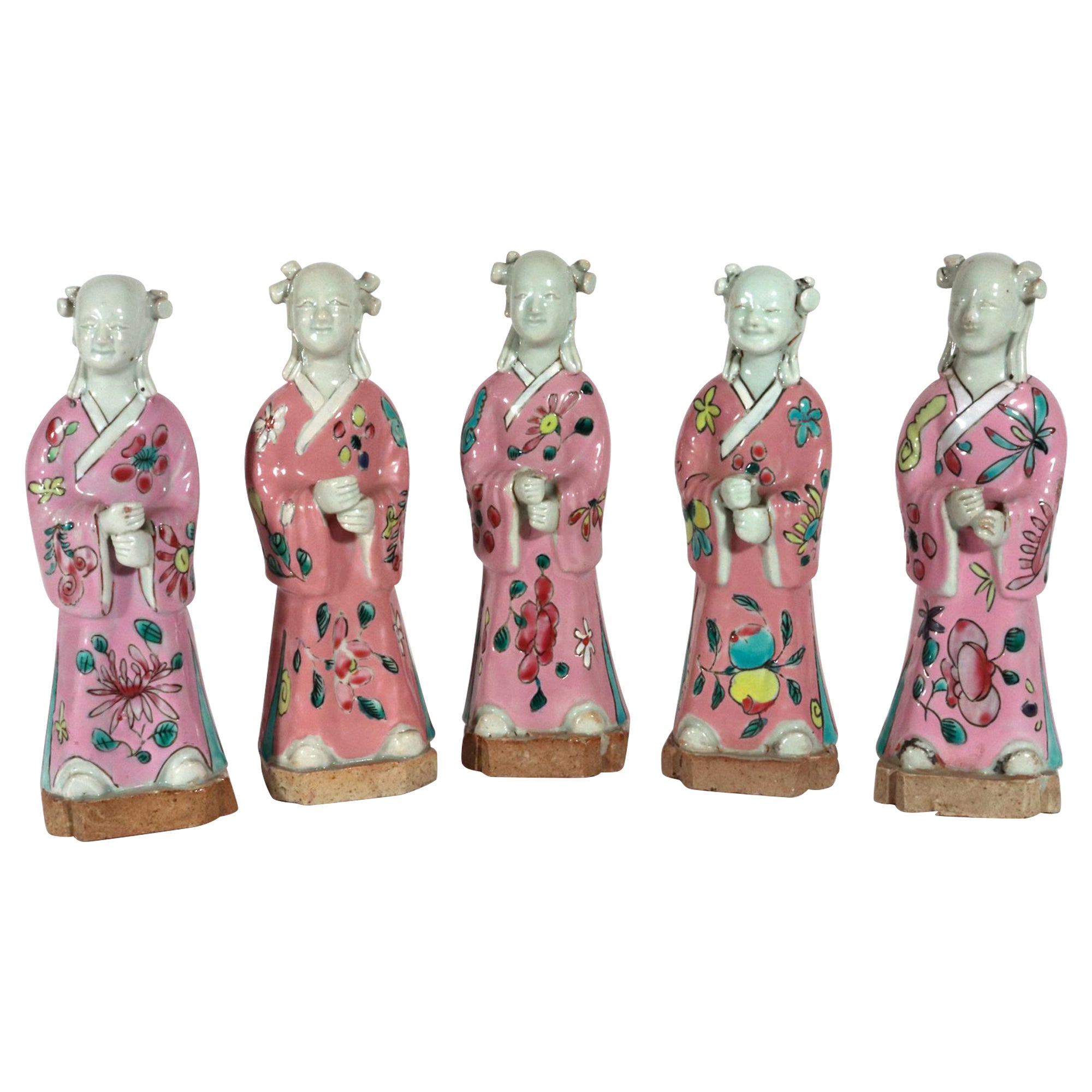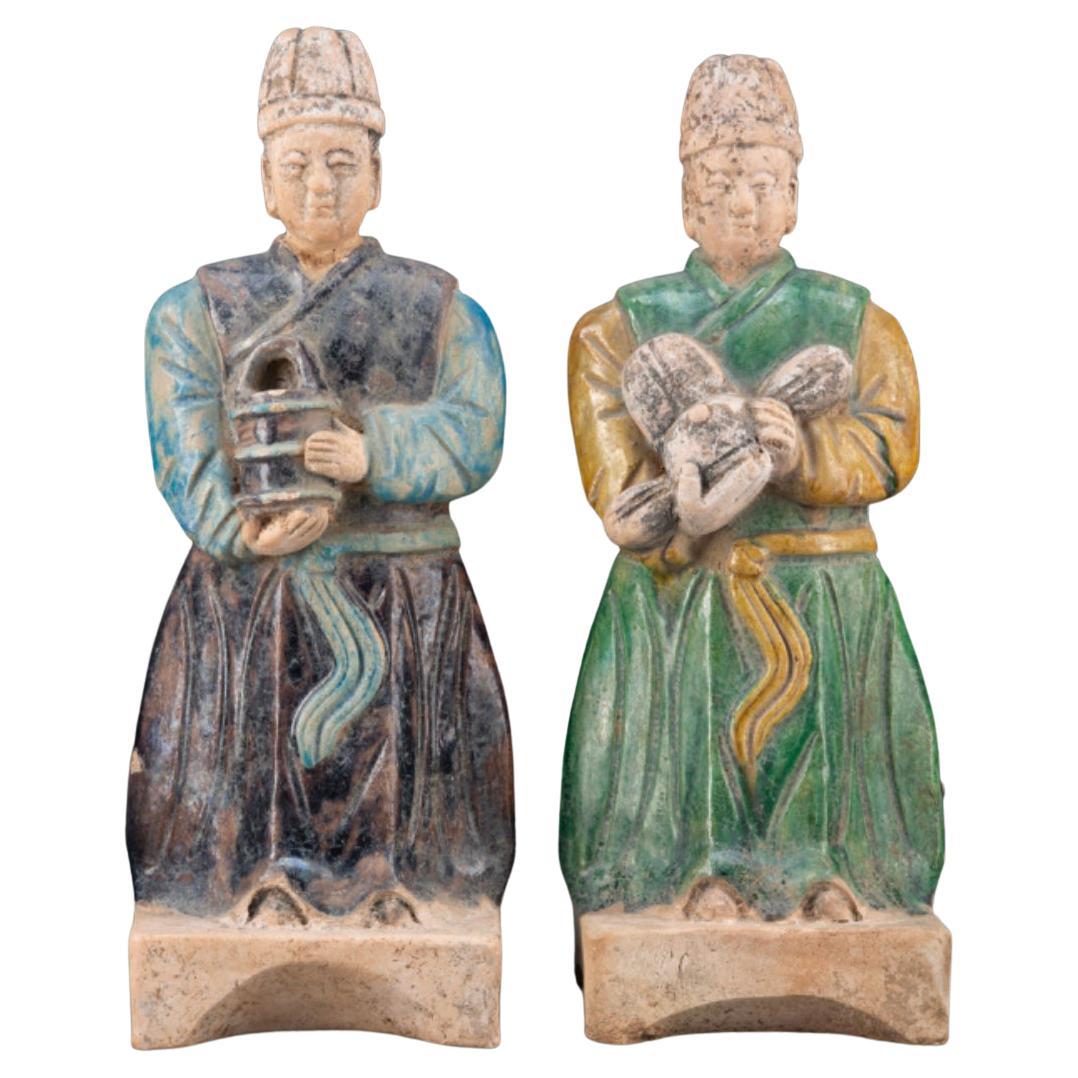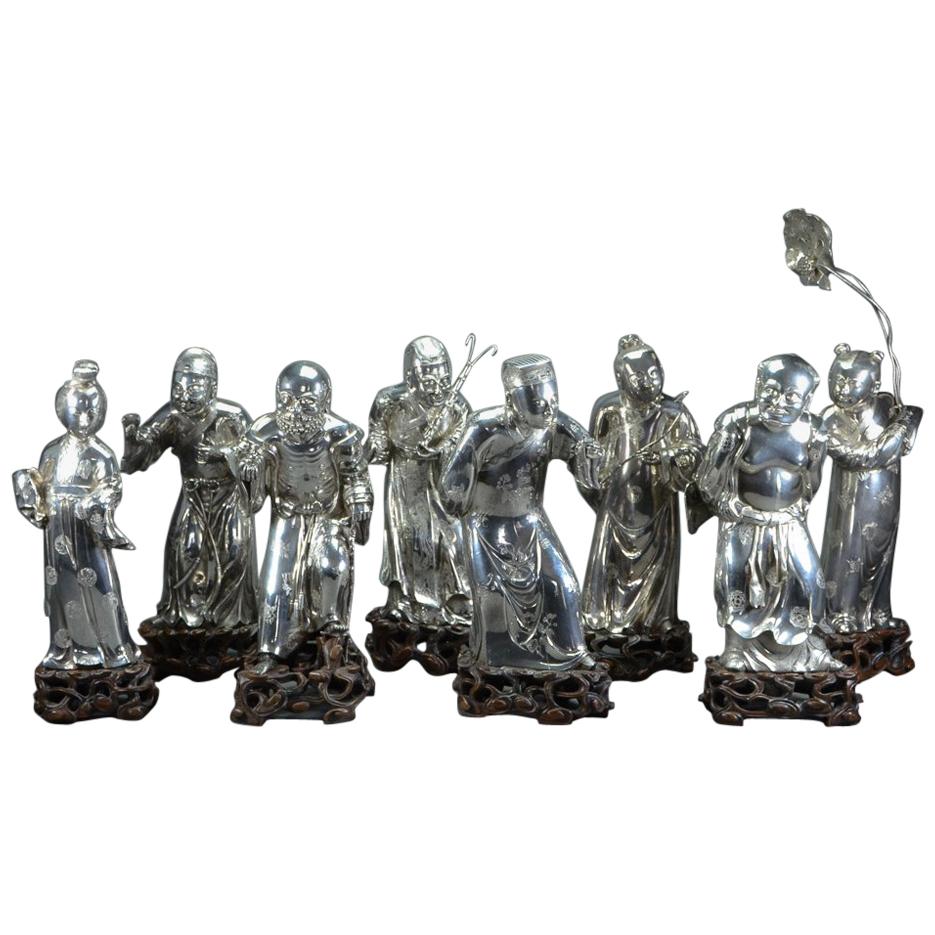Items Similar to Massive Pair of Chinese Cloisonne Enamel Figures of Attendants, Qing Dynasty
Want more images or videos?
Request additional images or videos from the seller
1 of 14
Massive Pair of Chinese Cloisonne Enamel Figures of Attendants, Qing Dynasty
About the Item
A rare and massive pair of Chinese cloisonne enamel figures of attendants, Qing Dynasty.
Each standing figure similarly depicted with hands raised overhead supporting a large circular tray, all raised on a tall octagonal waisted stand inserted with twelve evenly spaced stanchions connected by loose-ring chains, the figures with gilt faces, necks and chests, each attired in loose garments with foliate roundels against a white or yellow ground and turquoise borders, the tray interiors with central medallions of confronting phoenix and striding dragons on the sides, the exterior with stylized lotus, repeated on the stands with large central polychrome classic lotus on a white ground.
Cloisonné figures of this size are unusual and most likely intended for a room of grand and large dimension.
The form and large size of the present pair is consistent with the grand taste of the Empress Dowager Cixi. She ordered the partial reconstruction and restoration and new buildings for the summer palace in 1860 and it was known to be her favorite residence. Several photos of the Empress Dowager show her flanked by large pyramids of towering fruit atop circular trays and it is possible that this pair were used for a similar purpose. Examples of some of these photos are in the Freer and Sackler archives in Washington, DC which hold forty-four photo-negative portraits of Cixi.
48.5" high x 21" wide x 21" deep
PROVENANCE:
Sotheby's, New York, Fine Chinese Ceramics & Works of Art, September 16, 2014, lot 602
Private collection, Austin, Texas.
Collection of C.T. Howell.
Condition: Some repairs to enamel, scattered losses to enamel in some areas, and rubbing to gilt in each figure.
- Dimensions:Height: 48.5 in (123.19 cm)Width: 21 in (53.34 cm)Depth: 21 in (53.34 cm)
- Style:Chinese Export (Of the Period)
- Materials and Techniques:
- Place of Origin:
- Period:
- Date of Manufacture:circa 1860
- Condition:Wear consistent with age and use. Minor fading.
- Seller Location:New York, NY
- Reference Number:1stDibs: LU1798226101092
About the Seller
5.0
Vetted Seller
These experienced sellers undergo a comprehensive evaluation by our team of in-house experts.
Established in 1980
1stDibs seller since 2016
58 sales on 1stDibs
Typical response time: <1 hour
- ShippingRetrieving quote...Ships From: New York, NY
- Return PolicyA return for this item may be initiated within 7 days of delivery.
More From This SellerView All
- Massive Museum Pair of Meiji Period Japanese Cloisonne Enamel Chargers PlatesLocated in New York, NYA massive Museum pair of Meiji Period Japanese Cloisonne Enamel chargers plates, attributed to Hayashi Kodenji Studio, 19th century. Each measuring ...Category
Antique 19th Century Japanese Meiji Decorative Art
MaterialsEnamel
- Large Pair of Japanese Cloisonne Enamel Lanterns Attributed to Kaji TsunekichiLocated in New York, NYA Large Pair of Japanese Cloisonne Enamel Lanterns Attributed to Kaji Tsunekichi, Edo Period, 19th century Japanese cloisonne lanterns were made during the Meiji period, from the late 19th to early 20th century, and were often used as decorative lighting fixtures in temples and shrines. Kaji Tsunekichi (1866-1916) was a Japanese cloisonné artist who was active in the late 19th and early 20th centuries. He was born in Tokyo and learned the art of cloisonné from his father, Kaji Sataro, who was also a cloisonné artist. He was renowned for his mastery of the shippo-yaki technique, which involves creating intricate designs with thin wires on a metal base before filling in the spaces with enamel. Tsunekichi was known for his exceptional technical skills and his ability to create intricate designs with vibrant colors. His works often featured nature motifs, such as flowers, birds, and fish, which were rendered in a highly detailed and naturalistic style. He also experimented with new techniques, such as plique-à-jour, a type of cloisonné that creates a stained-glass effect. Tsunekichi's works were highly prized during his lifetime and continue to be sought after by collectors today. He won numerous awards for his cloisonné creations, including a Gold Medal at the 1900 Exposition Universelle in Paris. His works are characterized by their fine wirework, precise enamel application, and attention to detail. Some of Tsunekichi's most famous works include a pair of large cloisonné vases...Category
Antique 19th Century Japanese Edo Metalwork
MaterialsCopper, Enamel
- Large Pair of Japanese Cloisonne Enamel Vases Attributed to Honda YasaburoLocated in New York, NYA large pair of Japanese Cloisonne Enamel vases attributed to Honda Yasaburo, 19th century. Finley decorated with the rich enamel colors of orange and green, these vases are desig...Category
Antique 19th Century Japanese Meiji Metalwork
MaterialsCopper, Enamel
- An Exquisite Pair Of Japanese Cloisonné Enamel Vases with Chrysanthemum BlossomsLocated in New York, NYAn Exquisite Pair Of Japanese Cloisonné Enamel Vases with Chrysanthemum Blossoms, Attributed to Hayashi, Meiji Period. Experience the exquisite craftsmanship of the Meiji period wit...Category
Antique 19th Century Japanese Meiji Metalwork
MaterialsEnamel
- Large Pair of Meiji Period Japanese Cloisonne Enamel Double Dragon VasesLocated in New York, NYA large pair of Meiji Period Japanese Cloisonne Enamel Double Dragon Vases, 19th century. Japanese cloisonne enamel dragon vases are highly ...Category
Antique 19th Century Japanese Meiji Metalwork
MaterialsCopper, Enamel
- Large Pair of Meiji Period Japanese Cloisonne Enamel Vases Attributed to GotoLocated in New York, NYA large pair of Meiji Period Japanese cloisonne enamel vases attributed to Goto Seizaburo, 19th century. These vases were made during the Meiji period (1868-1912) in Japan and are...Category
Antique 19th Century Japanese Meiji Metalwork
MaterialsCopper, Enamel
You May Also Like
- Two Massive Late Qing Cloisonné Enamel Models of CranesLocated in London, GBTwo massive late Qing cloisonné enamel models of cranes Chinese, circa 1900 Measures: Height 187cm, width 52cm, depth 50cm These extraordinary Chin...Category
Antique Early 1900s Chinese Animal Sculptures
MaterialsEnamel
- Chinese Export Porcelain Figures of Attendants, Set of FiveLocated in Downingtown, PAChinese Export Porcelain Figures of Attendants, Set of Five, Circa 1780 The set of five Chinese Export porcelain figures are painted in famille rose enamels with a purple robe and s...Category
Antique Late 18th Century Chinese Chinese Export Figurative Sculptures
MaterialsPorcelain
- Large Chinese Cloisonne Enamel Bowl, Qing DynastyLocated in Vero Beach, FLLarge Chinese Cloisonne enamel bowl, Qing Dynasty Exceptional and finely decorated Chinese cloisonne punch bowl with gilt metal foot and rim. The bowl has slightly flaring sides ...Category
Early 20th Century Chinese Qing Metalwork
MaterialsCopper, Enamel
- Chinese Ming Dynasty Glazed Pottery AttendantsLocated in Dallas, TXA pair of Chinese Ming Dynasty glazed earthenware figure of Attendant The condition of these 5 century old glazed pottery tomb figures is outstand...Category
Antique 16th Century Chinese Ming Figurative Sculptures
MaterialsPottery
- Silver Figures of Eight Immortals Yangqinghe Jiuji Marks, Late Qing DynastyLocated in New York, NYImportant and rare silver figures of eight immortals Yangqinghe Jiuji marks, Late Qing dynasty. Each hollow figure portraying one of the immortals in an animated pose, with highly detailed facial features, four pierced with apertures for the insertion of facial hair, clad in finely chased robes, all but two with their characteristic attributes, their bases bearing either two seal marks reading Yangqinghe Jiuji gongyibu and Zhe'ning Hu Qiusheng zao, or three marks in regular script reading Yangqinghe Jiuji gongyibu, Shang and Sheng zuo, original hand-carved wood stands. Measures: 11 1/4in (28.5cm) high (tallest one). The earliest records of the silver atelier known as Yangqinghe date to 1775 in Shanghai...Category
Antique 1890s Chinese Chinese Export Metalwork
MaterialsSilver
- Pair of Chinese Cloisonné TigersLocated in Houston, TXA stunning pair of late 20th century life-size Chinese cloisonné tigers from the Baron Estate. In Chinese symbolism, these tigers represents the ma...Category
Late 20th Century Chinese Chinese Export Sculptures and Carvings
MaterialsBrass
Recently Viewed
View AllMore Ways To Browse
Chinese Works Of Art
Antique Photo Collections
Hold China
Pair Massive
Enamel Neck
China Cloisonne
Chinese Cloisonne
Pair Of Chinese Stand
Antique Chinese Ring
Antique Chinese Rings
Dynasty Fine China
China Fruit
Chinese Fruit
Chinese Figures Pair
Pair Of Chinese Figures
Antique Negatives
Grays Antique Rings
Chinese Cloisonne Enameled





